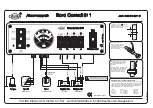
Optical Camshaft Position (CMP) Sensor
• Theory of Operation
These CMP sensors are classified as “CMP Sensors - High Resolution” in industry.
The optical CMP sensors are high resolution (accuracy) digital sensors which generate the CMP signal, that is a
high frequency (hundreds of Hz to several kHz) square wave switching between zero and V Ref.
The opt ical CMP sensors can sense position of a rotating component even without the engine running and t heir
pulse amplitude remains constant with variations in speed. They are not affected by electromagnetic interference
(EMI). They are used to switch the ignition and/or fuel injection triggering circuits on and off.
The opt ical sensor consis ts of a rotat ing disk wit h s lot s in it, two f iber opt ic light pipes, and LE D, and a
phototransistor as the light sensor. An amplifier is coupled to the phototransistor to create a strong enough signal for
use by other electronic devices, such as PCM or ignition module.
The phototransistor and amplifier create a digital output signal (on/off pulse)
• Symptoms [OBD II DTC’s: P0340 ~ P0349, P0365 ~ P0369, P0390 ~ P0394]
No or hard starts, stall at stops, misfires, poor fuel economy, emissions failure
• Test Procedure
1. Connect the CH A lead to the sensor output or HI and its ground lead to the sensor output LO or GND.
2. With K OE R (Key On, Engine Running), let t he engine idle, or use the thrott le to accelerate or decelerate the
engine or drive the vehicle as needed to make the driveability, or emissions, problem occur.
3. Use the Glitch Snare mode to catch dropouts or stabilize waveforms when a “sync” pulse is created.
• Reference Waveform
VEHICLE INFORMATION
YEAR
: 1989
MAKE
: Mitsubishi
MODEL
: Montero
ENGINE
: 3.0 L
FUELSYS : Multiport Fuel Injection
PCM_PIN : 23 Red wire at PCM
STATUS
: KOER (Key On Running)
RPM
: Idle
ENG_TMP : Operating Temperature
VACUUM : 20 In. Hg
MILEAGE : 184066
6-19
FREQ = 35.7 Hz
MAX = 4.93 V
MIN = 133 mV
Fixed Pulse Width signal.
Frequency increases with
increasing engine RPM.
The amplitude, frequency, and shape should be all consistent in the waveform from
pulse to pulse. The amplitude should be sufficient, the time between pulses repeatable
(except for “sync” pulses), and the shapes repeatable and predictable. Consistency is
the key.
• Symptoms [OBD II DTC’s: P0340 ~ P0349, P0365 ~ P0369, P0390 ~ P0394]
Long cranking time, poor fuel economy, emissions failure
• Test Procedure
1. Connect the CH A lead to the sensor output or HI and its ground lead to the sensor output LO or GND.
2. With KOER (Key On, Engine Running), let the engine idle, or use t he throt tle to accelerate or decelerate the
engine or drive the vehicle as needed to make the driveability, or emissions, problem occur.
3. Use the Glitch Snare mode to catch dropouts or stabilize waveforms when a “sync” pulse is created.
• Reference Waveform
VEHICLE INFORMATION
YEAR
: 1986
MAKE
: Oldsmobile
MODEL
: Toronado
ENGINE
: 3.8 L
FUELSYS : Multiport Fuel Injection
PCM_PIN : K BrnWht wire at ignition module
STATUS
: KOER (Key On Running)
RPM
: 2500
ENG_TMP : Operating Temperature
VACUUM : 20 In. Hg
MILEAGE : 123686
• Troubleshooting Tips
The duty cycle of the waveform changes only when a “sync” pulse is displayed. Any other changes in duty cycle can
mean troubles.
The top and bottom corners of the waveform should be sharp and voltage transitions of the edge should be straight
and vertical.
Make sure the waveform isn’t riding too high off the ground level. This could indicate a high resistance or bad ground
supply to the sensor.
Although the Hall CMP sensors are generally designed to operate in temperatures up to 318 °F (150 °C), they can
fail at certain temperatures (cold or hot).
6-18
The amplitude, frequency, and shape should be all consistent in the waveform from
pulse to pulse. The amplit ude should be suf ficient (usually equal to sensor supply
voltage), the time between pulses repeatable (except for “sync” pulses), and the shape
repeatable and predictable. Consistency is the key.
FREQ = 22.3 Hz
MAX = 7.33 V
MIN = -333 mV
Fixed Pulse Width signal.
Frequency increases with
increasing engine RPM.
Camshaft makes one
rotation in between pulses.
















































